Technology Innovations in China’s New Energy Vehicle Sector
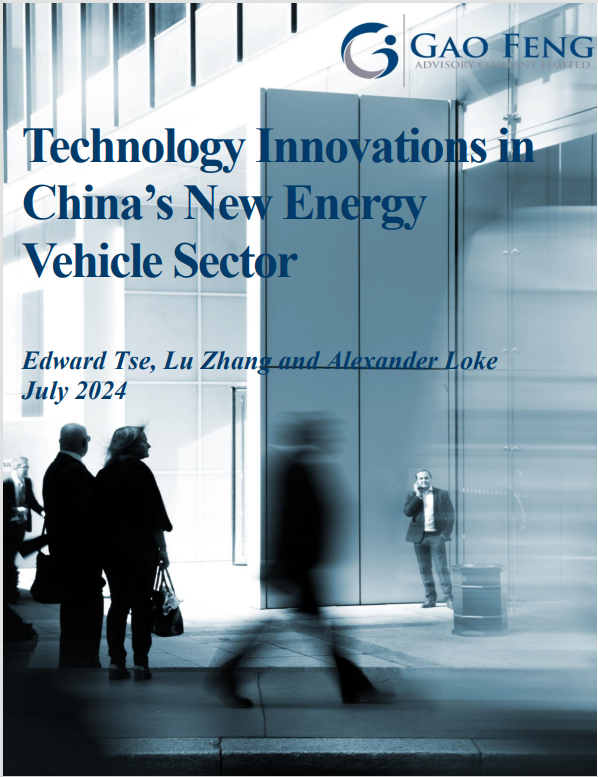
In this article, we explore some of the key transformative forces that are reshaping China's New Energy Vehicle (NEV) sector, these being advancements in the critical areas of intelligent cockpits, urban Navigation on Autopilot (NOA), and the evolution of fast charging and battery technology. They provide insights into how consumer-centric innovations and rapid technological advancements are driving the evolution of China’s automotive industry.
China’s New Energy Vehicle (NEV) sector is at the forefront of automotive innovation, driven by significant technological advancements and a strong consumer focus. As the largest automotive market continues to expand, both established companies and new entrants must adapt swiftly to remain competitive.
Rising Demand for Intelligent Cockpits Among Chinese Consumers
Driven by consumer preferences for more advanced technologies, user-friendly intelligent cockpits have been developing rapidly, redefining the standard for future automotive offerings. In China, intelligent cockpits that integrate comfort, convenience, and safety with personalized digital interactions are in high demand.
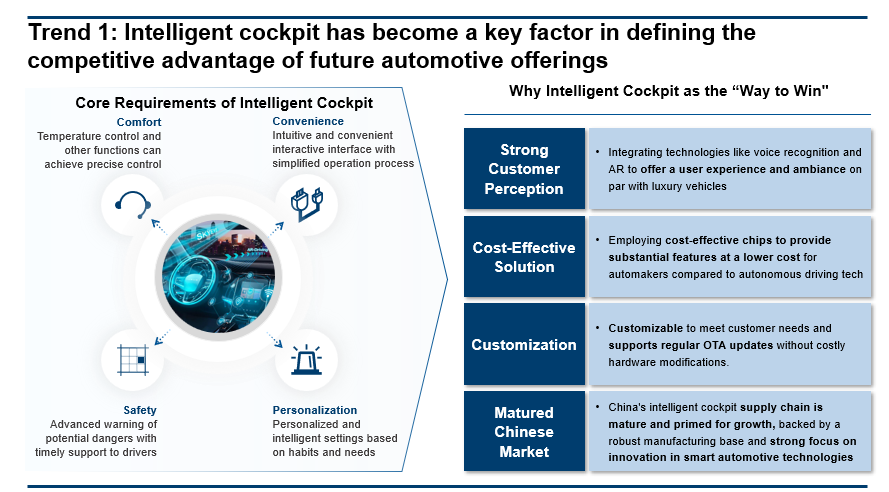
Source: Guotai Junan Securities, Gao Feng Analysis
By 2025, the penetration rate of intelligent cockpits in China is projected to reach ~76%, significantly surpassing the global average of around 59%. Among the numerous functionalities offered by intelligent cockpits, Augmented Reality Head-Up Displays (AR HUD) have emerged as a pivotal development direction. AR HUDs provide drivers with rich, interactive content without causing distraction, thereby enhancing both safety and user experience.
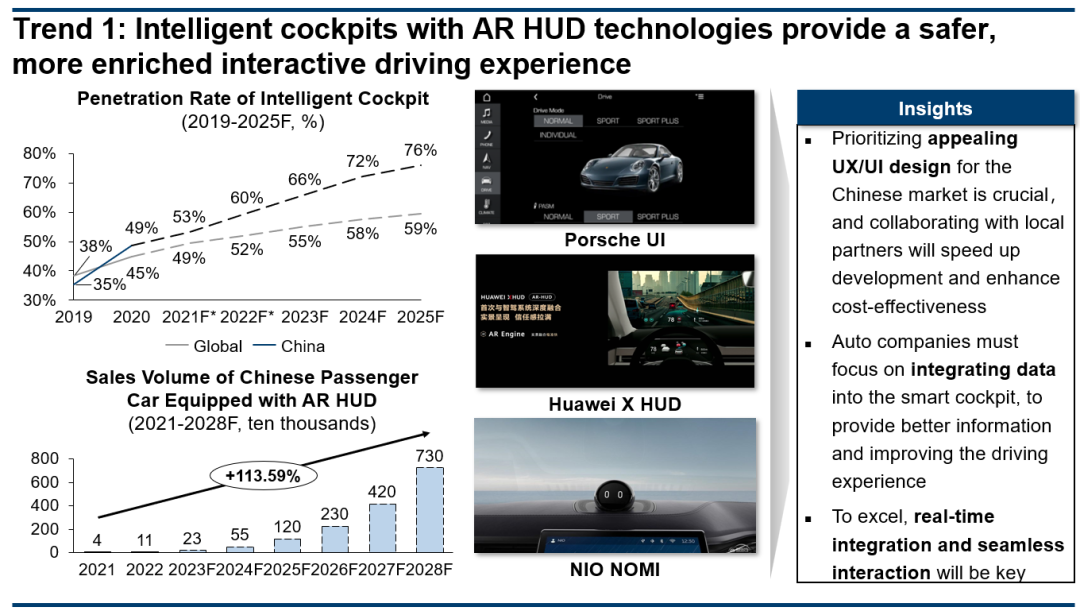
Source: Guotai Junan Securities, Gao Feng Analysis
For Original Equipment Manufacturers (OEMs), adopting user-centric UX/UI designs that cater specifically to Chinese consumers' preferences is essential. Collaborating with local partners can expedite development processes and enhance cost-effectiveness to capitalize on this trend. Furthermore, the functionality of intelligent cockpits must ensure real-time integration and seamless interaction to meet consumer expectations.
Urban NOA Defines the Future of Transportation
As autonomous driving technology rapidly advances, the development of Advanced Driver Assistance Systems (ADAS) is making significant strides, particularly in China, where complex road conditions and high customer expectations drive innovation. By 2025, more than half of the vehicles will be equipped with L2 level and above ADAS. Looking ahead to 2030, it is estimated that one-third of vehicles will have at least L3 level ADAS capabilities, where a driver is still necessary as a backup, the vehicle systems will be able to handle most driving tasks independently. Leading OEMs will begin to achieve full scenario coverage at Level 4 autonomy around 2026, capable of handling all driving tasks without human intervention.
Navigate on Autopilot (NOA) is emerging as a critical component in the evolution of NEVs, gaining significant traction among consumers. Approaching Level 3 partial autonomous capability, NOA is set to revolutionize intelligent driving across various environments.

Source: Guotai Junan Securities, Gao Feng Analysis
Urban NOA, specifically, is a crucial aspect of NOA’s redefining development. Over 70% of NOA applications will be concentrated in urban settings due to the complex road conditions and high traffic density in cities. Urban NOA systems face greater challenges than highway systems, requiring sophisticated technological solutions to navigate effectively. Features such as Automated Lane Change (ALC) and Traffic Jam Pilot (TJP) are particularly beneficial in urban environments, enhancing driving convenience and safety. The advanced functionalities offered by urban NOA make it highly attractive to consumers, promising a safer, more efficient urban driving experience.
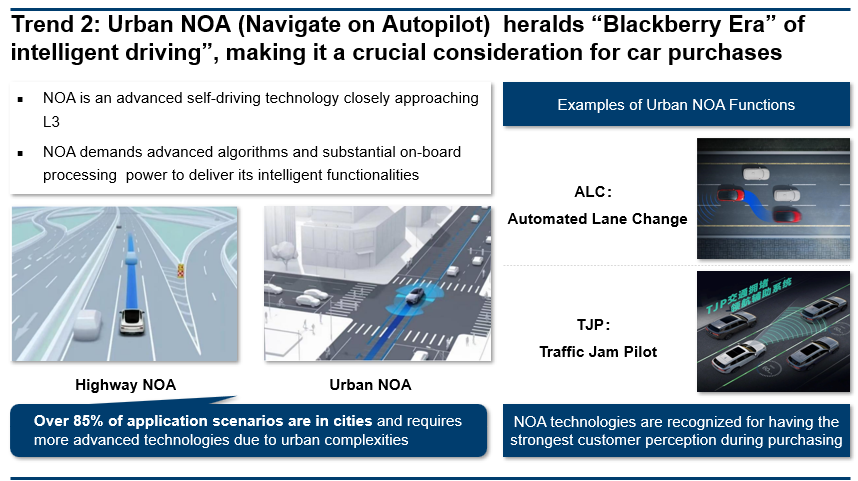
Source: Guotai Junan Securities, Gao Feng Analysis
A strategic focus on NOA will enable OEMs to capitalize on the growing demand for advanced autonomous driving features, ensuring they remain competitive and relevant in the rapidly evolving automotive landscape.
Fast Charging and Advances in Battery Technology Effectively Mitigate Range Anxiety
As NEVs achieve driving ranges of 600-700 km, which more than adequately meets the traveling needs of most Chinese consumers, primary concerns have shifted from range anxiety to recharging anxiety. A survey indicates that 74% of consumers consider fast charging essential for the practical use of NEVs. The introduction of 800V high-voltage charging has significantly enhanced fast charging, marking a key advancement in NEV development.
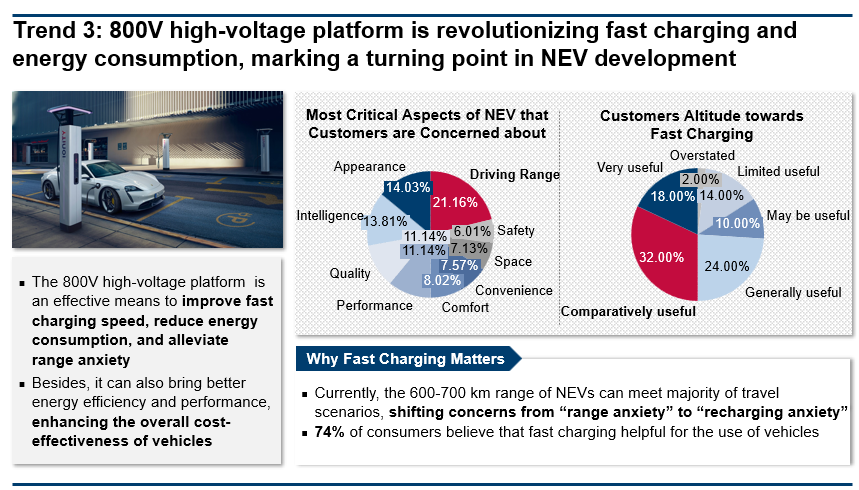
Source: Guotai Junan Securities, Gao Feng Analysis
By 2026, 800V high-voltage charging solutions are expected to become the industry standard. Leading Chinese NEV companies have already completed research and development of these high-voltage fast charging technologies and are investing heavily in deploying 800V compatible supercharging stations. For OEMs, prioritizing the development and deployment of these solutions is essential to remain competitive and meet the evolving demands of the NEV market.
Beyond accelerating the development and implementation of fast-charging solutions to alleviate recharging anxiety and maintain competitiveness, OEMs should also consider forming strategic partnerships with high-quality battery suppliers. The choice of battery significantly impacts vehicle performance, safety, and cost-effectiveness. Collaborations with top-tier battery suppliers drive innovation, enhance market competitiveness, and are crucial for attracting and retaining customers in China’s rapidly evolving NEV market. Such partnerships are vital to achieving sustained growth and leadership in the NEV landscape.
Implications for the NEV Sector
The NEV industry in China is undergoing a profound transformation driven by a fundamental shift toward user-centricity. As the world's largest automotive market evolves, consumer expectations go beyond basic transportation needs. Today’s NEV buyers in China demand vehicles that offer eco-friendly performance while seamlessly integrating with their digital lifestyles, providing advanced safety features, and delivering an enhanced overall user experience. This user-centric evolution is reshaping the entire NEV ecosystem, from product design and manufacturing to sales and after-market services.
Three key technology development trends have emerged in response to these changing consumer demands. Many OEMs and stakeholders in the NEV industry are positioning themselves to harness these developments effectively. In the NEV sector, it is now a given that OEMs should invest in digital capabilities, foster strategic partnerships, and commit to sustainability.
Acknowledgement
Thanks to our Consultant William Shi for providing support in writing this article.


Gao Feng Advisory
Gao Feng Advisory Company is a professional strategy and management consulting as well as investment advisory firm with roots in China coupled with global vision, capabilities, and a broad resources network
Wechat Official Account:Gaofengadv
Shanghai Office
Tel: +86 021-63339611
Fax: +86 021-63267808
Hong Kong Office
Tel: +852 39598856
Fax: +852 25883499
Beijing Office
Tel: +86 010-84418422
Fax: +86 010-84418423
E-Mail: info@gaofengadv.com
Website: www.gaofengadv.com
Weibo: 高风咨询公司
